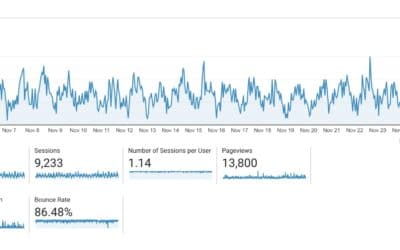Google Search Console (GSC) is an invaluable tool for website owners, particularly those who want to increase their organic (aka free) traffic.
If you’ve heard about it but are still asking yourself “What is Google Search Console?”, you’re not alone. Most websites aren’t making use of this tool–a tool that might be the most important one when it comes to getting visitors to your site.
While there are many beneficial features, there is 1 primary reason you need GSC.
1 Simple Reason Why You Need Google Search Console
You’ll be able to see what people are searching for when your website appears in search engines.
With this knowledge you’ll then be able to tailor your content to be found even more easily online!
Let’s first talk about what Google Search Console is.
What is Google Search Console?
Originally named “Google Webmaster Tools,” GSC is a free, web-based service from Google that provides site owners with information on how Google sees and interpretes their website.
You can use it to gain a solid understanding of how Google sees your site; how many pages are in its index, what kinds of searches are driving traffic to your site, and more.
If you are familiar with Google Analytics, you know that it gives you the “internal” data for your site–including the number of visitors, how long they stayed on the site, the pages they viewed, purchase data, and more. Google Analytics provides your internal site data.
You can think of Google Search Console as the”outside” view of your site. It gives you data about how your site appears in Google, what searches cause your site to appear in Google, how many pages it’s crawled and indexed, and points out issues Google might be having crawling your site and more.
Why is Google Search Console important for website owners?
As a free but powerful tool, every website owner should be familiar with GSC. It includes several features to help improve your site’s performance.
Performance Reporting
Likely the most useful feature of GSC, performance reporting lets you see what searches and keywords are causing your site to appear in Google. It gives you a list of each search that caused your site to appear along with the number of clicks, impressions, click-through-rate, and average position. You can also see what individual pages are appearing in search results, as well as their average ranking. GSC makes it straightforward to understand what searches are causing your site to appear in Google so that you can identify and improve your organic ranking.
Index and coverage data
Another useful feature is the crawling and indexing reports, which show you how many pages on your site Google knows about as well as how many are actually included in their index as returnable pages. It can help you spot issues that are preventing Google from properly crawling your site, like improperly placed no-index tags.
Sitemap Verification
GSC also lets you submit XML sitemaps and verify they are being crawled correctly. Once you’ve created your sitemap, you can submit it to Google via GSC for crawling and indexing. Google will show how many URLs it found in the sitemap, whether it was processed correctly, what if any pages were excluded and warn you of any issues with it.
Enhancement Suggestions
GST also provides you with information about your site experience, with particular emphasis on mobile and speed. As more and more people use their phones to browse the internet, page load times are becoming increasingly important. If your site doesn’t load quickly many users will simply abandon your site and go somewhere else. GSC lets you see data about load times as well as other mobile usability issues.
How to sign up for Google Search Console
GSC is free to sign up for, although you will need to prove to Google that you are the site owner. The first step is to visit the sign-up page and add your site.
You’ll need to choose a way to verify your site ownership via one of two methods, “Domain” or “URL Prefix.”
- Domain — With this, you’ll verify your domain, yoursite.com. This will include all your site’s pages, including subdomains (like www.yoursite.com and shop.yoursite.com), all directories, and any secure or insecure pages–everything! It requires you to add a new TXT record through your host’s DNS manager (you’d login to the location you bought your domain–such as godaddy.com). It can be a bit more complicated but it will give you more data. Go here for more detailed information from Google on verifying your domain via DNS record.
- URL Prefix — This will only include data for URLs under the specified address (for example ONLY www.yoursite.com — not shop.yoursite.com!). If you don’t have access to your DNS manager, the URL prefix method is a little easier because it allows more verification methods. The downside is that you’ll have to claim each version of your site (HTTP, HTTPS, www vs non-www). There are several ways to verify ownership via the URL Prefix, including uploading a small text file to your main directory, adding a meta tag to your home page, verifying through an existing Google Analytics or Tag Manager account, or by an interface with your domain name provider.
Depending on your DNS provider, it can take a few minutes or in some cases up to 24 for DNS changes to be propagated. But once you’ve verified ownership with Google you’ll be ready to start using GSC.
Once you’re setup, the amount of insight you’ll gain into how folks online are finding your site is invaluable!
If you want more detailed information on the things you can do to improve your site’s ranking on search engines, go ahead and request a Site Score to find out the areas your site needs improvement!




